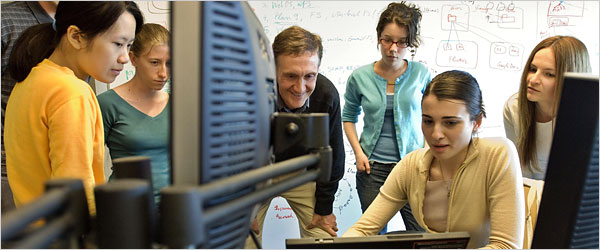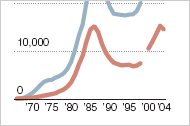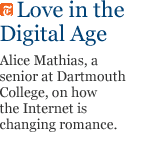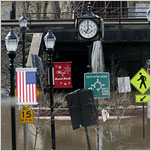CAMBRIDGE, Mass. — For decades, undergraduate women have been moving in ever greater numbers into science and engineering departments at American universities. Yet even as they approach or exceed enrollment parity in mathematics, biology and other fields, there is one area in which their presence relative to men is static or even shrinking: computer science.
Multimedia
Readers’ Opinions
Share Your Thoughts
What do you think accounts for the lower number of women enrolled in computer science programs?

Lenore Blum with computer science students at Carnegie Mellon.
Women received about 38 percent of the computer science bachelor’s degrees awarded in the United States in 1985, the peak year, but in 2003, the figure was only about 28 percent, according to the National Science Foundation.
At universities that also offer graduate degrees in computer science, only 17 percent of the field’s bachelor’s degrees in the 2003-4 academic year went to women, according to the Taulbee Survey, conducted annually by an organization for computer science research.
Since then, many in the field say, the situation has worsened. They say computing is the only realm of science or technology in which women are consistently giving ground. They also worry that the number of women is dropping in graduate programs and in industry.
They are concerned about this trend, they say, not just because they want to see young women share the field’s challenges and rewards, but also because they regard the relative absence of women as a troubling indicator for American computer science generally — and for the economic competitiveness that depends on it.
“Women are the canaries in the coal mine,” Lenore Blum, a computer scientist at Carnegie Mellon University, told an audience at Harvard University in March, in a talk on this “crisis” in computer science. Factors driving women away will eventually drive men away as well, she and others say.
These experts play down the two explanations most often offered for flagging enrollment: the dot-com bust and the movement of high-tech jobs offshore.
“People think there are no jobs, but that is not true,” said Jan Cuny, a computer scientist at the University of Oregon who directs a National Science Foundation program to broaden participation in computer science. “There are more people involved in computer science now than at the height of the dot-com boom.”
And there is widespread misunderstanding about jobs moving abroad, said Ed Lazowska, a computer scientist at the University of Washington. Companies may establish installations overseas to meet local licensing requirements or in hopes of influencing regulations, he said, “but the truth is when companies offshore they are more or less doing it for access to talent.”
“Cheap labor is not high on the list,” Dr. Lazowska said. “It is access to talent.”
According to the Bureau of Labor Statistics, demand for computer scientists in the United States will only increase in coming years, Dr. Cuny said. “If you look at the demographics of the country, if we are not going to get our new professionals from women and minorities and persons with disabilities, we are not going to have enough.”
The big problems, these and other experts say, are prevailing images of what computer science is and who can do it.
“The nerd factor is huge,” Dr. Cuny said. According to a 2005 report by the National Center for Women and Information Technology, an academic-industry collaborative formed to address the issue, when high school girls think of computer scientists they think of geeks, pocket protectors, isolated cubicles and a lifetime of staring into a screen writing computer code.
This image discourages members of both sexes, but the problem seems to be more prevalent among women. “They think of it as programming,” Dr. Cuny said. “They don’t think of it as revolutionizing the way we are going to do medicine or create synthetic molecules or study our impact on the climate of the earth.”
Like others in the field, Dr. Cuny speaks almost lyrically about the intellectual challenge of applying the study of cognition and the tools of computation to medicine, ecology, law, chemistry — virtually any kind of human endeavor.
“The use of computers in modern life is totally ubiquitous,” said Barbara G. Ryder, a professor of computer science at Rutgers University. “So there are niches all over for people who understand what the technology can do and also for people who want to advance the technology.
“But students don’t see that,” Dr. Ryder said. “And it seems to be happening more with the women than with the men.”
The Advanced Placement high school course in computer science may be part of the problem, according to Dr. Cuny. “The AP computer course is a disaster,” she said. “It teaches Java programming, which is very appealing to a lot of people, but not to others. It doesn’t teach what you can do with computers.”
She and others think the course needs to be redesigned.
But Dr. Lazowska said the criticism was somewhat unfair, given that introductory college computer courses, which the AP course is designed to replace, typically emphasize programming as well.
- 1
- 2
















